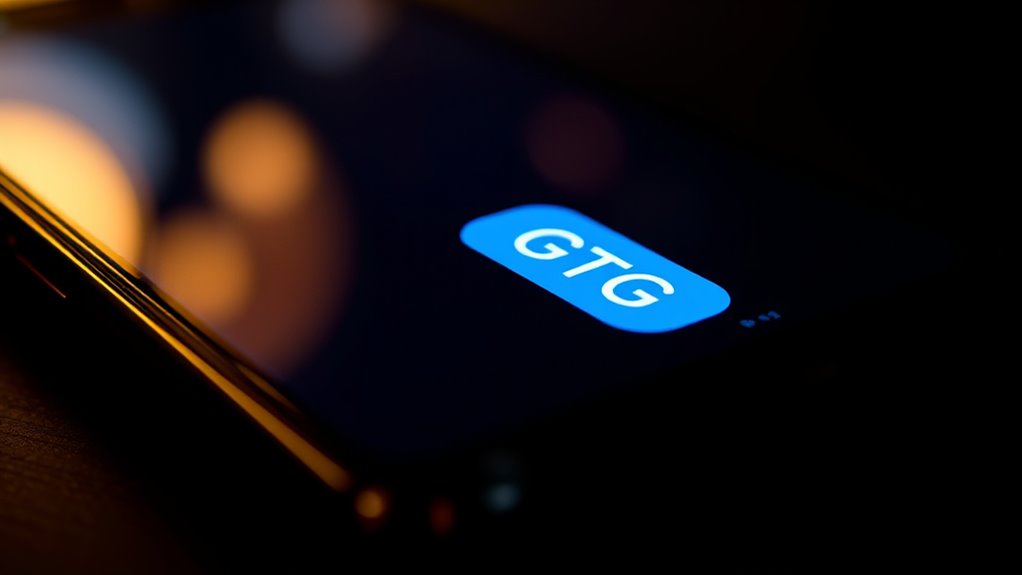GTG in text stands for “Got to Go,” used to quickly signal you’re leaving a conversation, especially in casual chats. It’s a shorthand way to let others know you’re ending the chat without being abrupt. Variations include G2G or Gotta go. While perfect for informal exchanges, avoid using it in professional or serious contexts. Want to understand more about its origins, proper usage, and related abbreviations? Keep exploring to learn the full picture.
Key Takeaways
- GTG stands for “Got to Go,” used to quickly indicate leaving a conversation.
- It originated in early texting as a shorthand for ending chats efficiently.
- Commonly used in casual contexts, but should be avoided in formal or professional communication.
- Variations include G2G and Gotta go, with similar meanings for quick departure.
- Proper use involves matching the context to avoid miscommunication or sounding abrupt.
The Definition of GTG

Have you ever wondered what GTG means in a text message? In online communication, GTG stands for “Got to Go.” It’s a quick way to let someone know you’re leaving or need to end the conversation. Using abbreviations like GTG aligns with texting etiquette by keeping messages brief and clear. When you use GTG, you’re practicing efficient communication, making it easier for others to understand your intentions without lengthy explanations. It’s often used in casual conversations when you’re in a hurry or don’t want to get into detailed explanations. Knowing what GTG means helps you navigate online communication smoothly, ensuring your messages are concise but polite, and that you’re respectful of others’ time. Additionally, understanding common abbreviations can enhance your digital communication skills during casual chats.
How GTG Is Used in Conversations
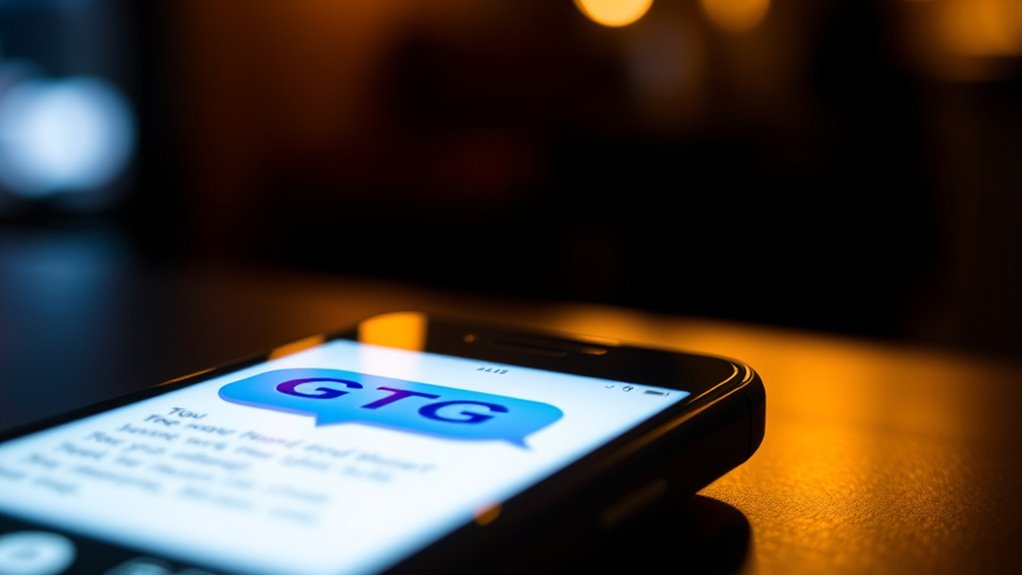
In everyday conversations, GTG is often used to quickly signal that you need to end the chat. While it’s common in casual texting, you should be cautious about using GTG in formal context or professional communication. In professional settings, it’s better to choose clear, polite phrases like “I need to go now” or “Talk to you later.” However, among colleagues or friends, GTG can effectively convey that you’re about to leave or pause the conversation without sounding abrupt. It helps keep the tone casual and efficient. Remember, the key is to match your language to the context. Using GTG appropriately guarantees your message is understood while maintaining professionalism when necessary. Additionally, understanding the meaning of GTG can help you use it more effectively in various situations.
Variations of GTG in Texting
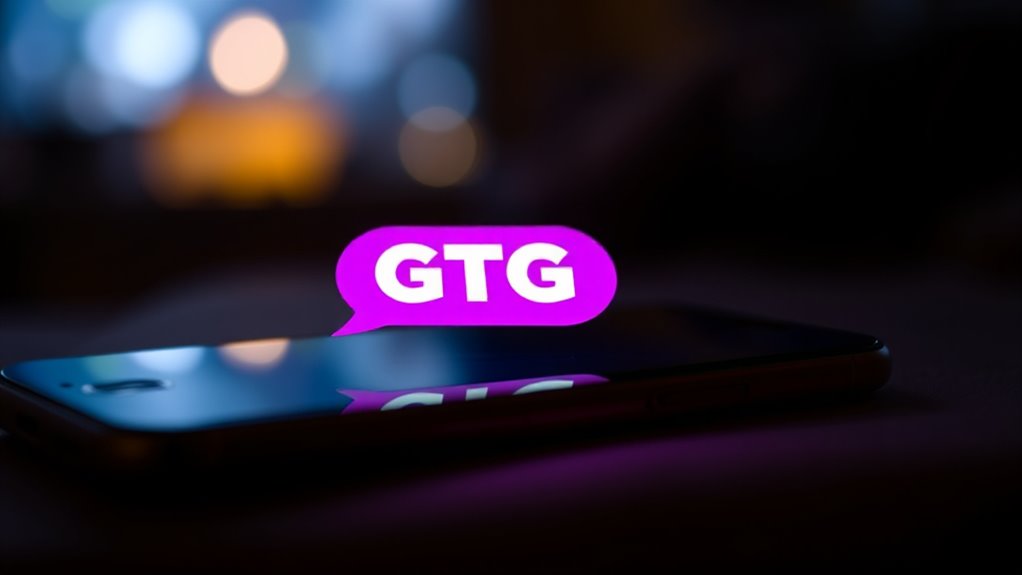
You’ll notice that GTG has various forms depending on how formal or casual your message is. Some people use more polished versions like “Got to go” in formal settings, while others stick with slang such as “G2G” or simply “Gotta go.” Understanding these differences helps you communicate clearly across different contexts. Recognizing digital literacy in messages can also help improve understanding of online communication styles.
Common Formal Variations
While GTG is a common shorthand for “got to go,” there are several formal or polite variations used in texting to convey the same message more professionally or gently. In formal email etiquette and professional communication standards, you might use phrases like “I must leave now,” “I need to sign off,” or “I will continue this conversation later.” These expressions maintain politeness while respecting formal communication norms. You can also use “Thank you for your time,” or “Looking forward to our next conversation,” to soften the message. These variations help guarantee your message remains respectful and clear, especially in professional contexts where you want to avoid overly casual language. They reflect a polished tone that aligns with formal communication standards. Incorporating communication etiquette ensures your message is both respectful and effective.
Casual and Slang Forms
Ever wondered how people keep their texts quick and casual when saying goodbye? Many use slang expressions or abbreviations to make casual communication faster and more relaxed. Besides GTG, you might see variations like G2G or Gotta go, which are simple, friendly ways to say you’re leaving. Some people also use phrases like “Catch you later” or “Talk soon” in a similar vein. These slang forms help keep conversations informal and spontaneous, perfect for texting. They save time and add a playful tone to your messages. Whether you choose a short abbreviation or a casual phrase, these variations make it easy to end chats without sounding too formal or distant. They reflect everyday language and keep your interactions light and friendly. Recognizing these expressions can also help you understand the evolving texting slang used in digital conversations.
When to Use GTG Appropriately

Knowing when to use GTG appropriately can help guarantee your messages remain clear and respectful of others’ time. It’s important to regard appropriate etiquette and timing considerations before sending GTG. Use it when you need to end a conversation quickly or when you’re about to be unavailable for a while. Avoid using GTG in serious or sensitive discussions, as it might seem dismissive or abrupt. Ensure your message context clearly indicates you’re not ignoring the other person but simply need to pause the conversation. If you’re unsure whether the timing is right, opt for a more polite response or explain your situation briefly. Being mindful of these factors helps you communicate effectively while maintaining respect and clarity. Additionally, understanding communication etiquette can further enhance your interactions and ensure your message is received as intended.
Examples of GTG in Real-Life Chats
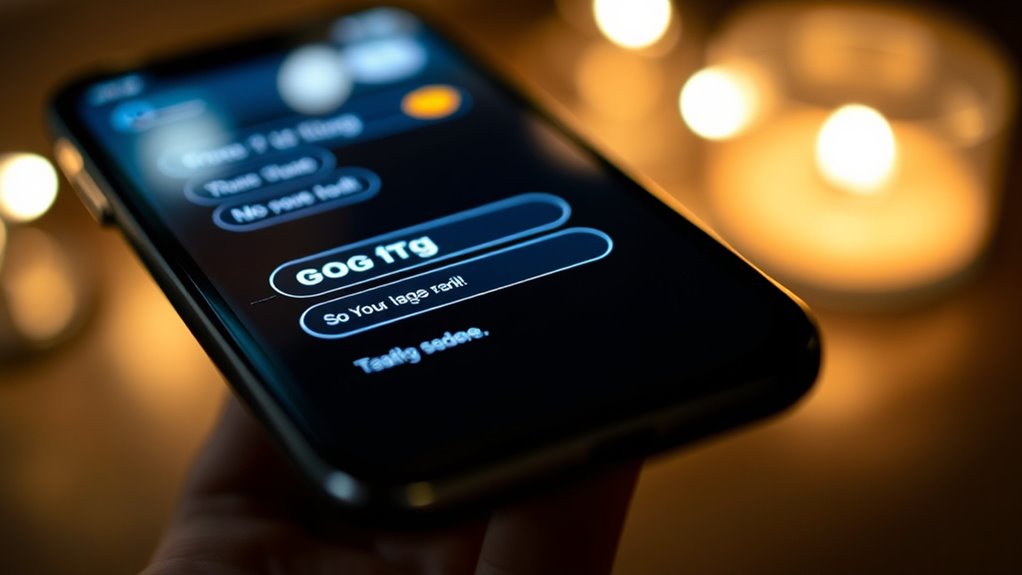
In everyday conversations, GTG often appears when someone needs to end a chat quickly. You might see it in casual conversations with friends or in professional communication when deadlines approach. For example, you could be chatting with a colleague and type, “Gotta run, GTG!” When time’s tight, GTG helps you politely wrap up. It’s common in:
- Quick goodbyes during busy days
- Ending casual chats without awkwardness
- Signaling the end of a professional exchange efficiently
Using GTG keeps conversations flowing smoothly, especially when you’re pressed for time. It’s a simple way to acknowledge the end without sounding abrupt, making your messages clear and respectful in any setting.
The Origin of the Term GTG
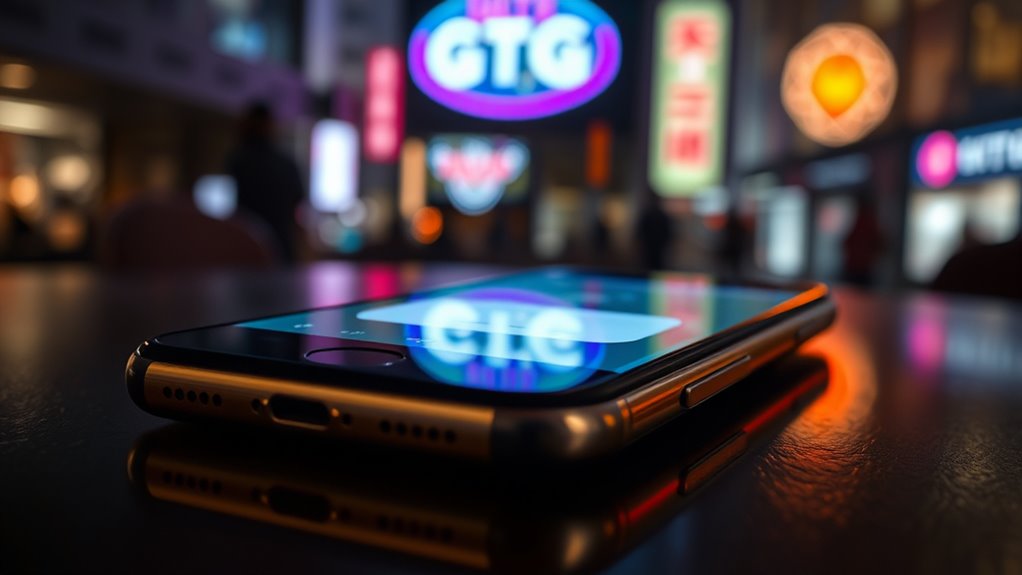
You might wonder how GTG first entered online conversations. It started with early texting, where abbreviations helped save time and space. Over time, its meaning evolved as it gained popularity in chatting communities worldwide.
Early Texting Usage
The term GTG, short for “got to go,” originated in the early days of text messaging when users needed quick, efficient ways to communicate their departure. During this time, emoji usage started to enhance messages, making quick goodbyes more expressive. Texting etiquette emphasized brevity, so abbreviations like GTG became popular to save time. You might have felt a mix of relief and urgency when sending or receiving such messages, knowing it was a courteous way to end a chat. Additionally, the use of abbreviations like GTG reflects the influence of digital communication on language evolution.
Popularity in Chatting
As texting grew more popular, abbreviations like GTG gained widespread use in everyday conversations. They became essential for maintaining proper texting etiquette while keeping messages brief and clear. In digital communication, people appreciated shortcuts that saved time and reduced misunderstandings. GTG, in particular, offered a quick way to indicate departure or the need to leave a chat without lengthy explanations. Its popularity spread as more users embraced instant messaging apps and social media platforms. The simplicity of GTG fit perfectly into the fast-paced nature of chatting, making it a staple abbreviation. Over time, its frequent use helped establish common texting norms, encouraging others to adopt similar shorthand for smoother and more efficient digital conversations. Additionally, understanding industry trends can help users stay updated on evolving communication styles and abbreviations.
Evolution of Meaning
GTG, short for “Got to go,” originated in the early days of digital communication as a quick way to signal that someone needed to leave a conversation or event. Over time, its meaning evolved alongside the rapid language changes driven by texting and online chats. You might feel nostalgic recalling when GTG was just a simple sign-off, but now it reflects more than just departure—it embodies the dynamic nature of language evolution in digital spaces. This evolution mirrors how angel number meanings adapt to new patterns and symbolic interpretations in modern communication.
Similar Acronyms and Their Meanings
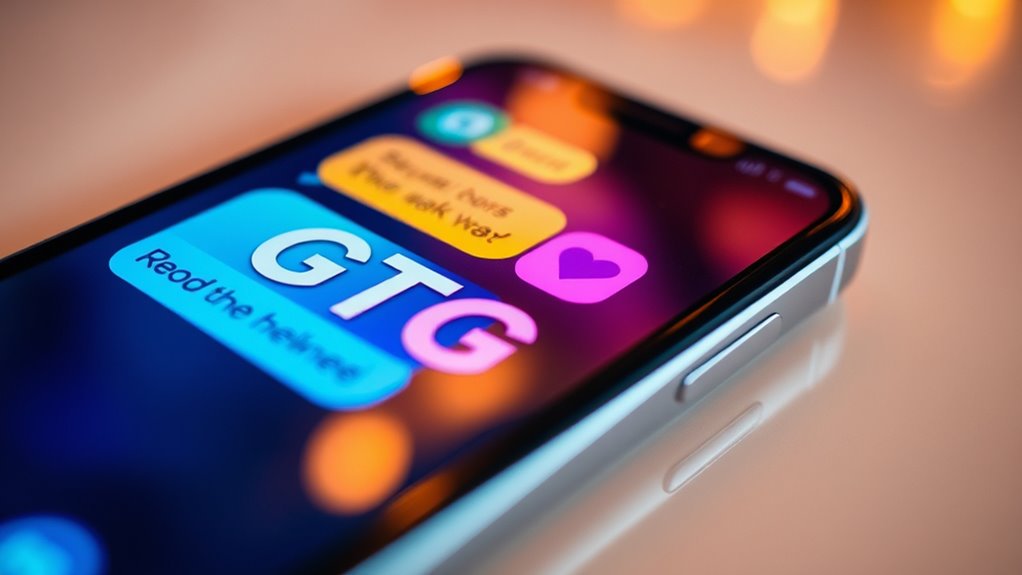
Numerous acronyms similar to GTG often pop up in text conversations, each carrying its own specific meaning. These online abbreviations are common in digital communication and reflect different texting etiquette. For example, “BRB” means “be right back,” indicating you’ll return soon. “TTYL” stands for “talk to you later,” used when you’re ending a chat politely. “OMG” expresses surprise or excitement. While these abbreviations help keep conversations quick and casual, understanding their meanings assures clear communication. Knowing the differences between these acronyms can improve your texting etiquette and prevent misunderstandings. Each abbreviation serves a unique purpose, so familiarizing yourself with them helps you navigate various situations smoothly in digital chats. Additionally, understanding the context in which these acronyms are used can enhance clear and effective communication.
Common Mistakes When Using GTG
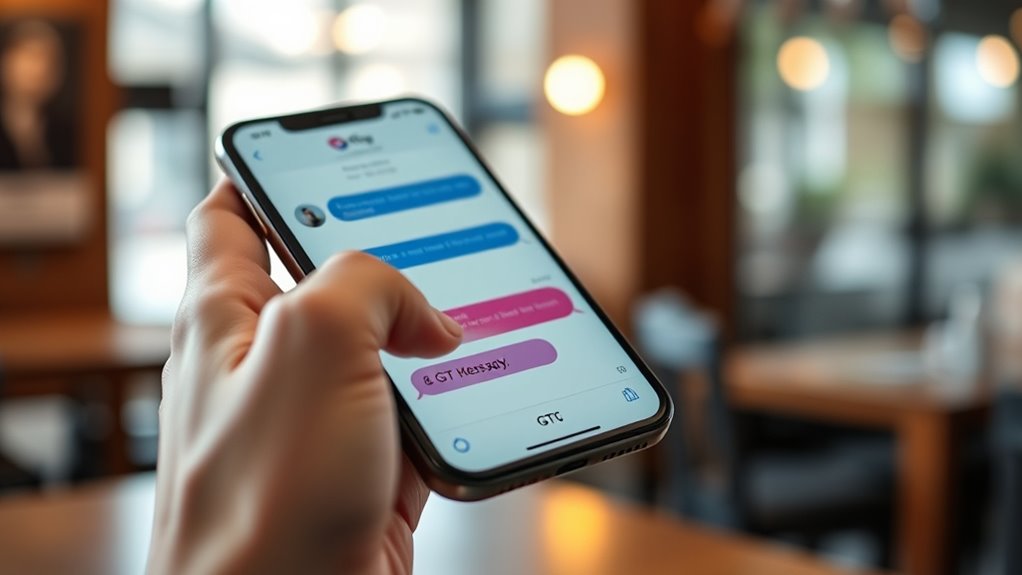
One common mistake when using GTG is assuming everyone knows what it means without considering context. This can lead to miscommunication or confusion, especially if you misuse abbreviations or ignore the situation. When you misuse abbreviations like GTG, you risk appearing careless or unprofessional. Ignoring context might cause your message to be misunderstood or taken the wrong way. To avoid this, be mindful of how and when you use GTG. Additionally, unfamiliarity with popular abbreviations like GTG can hinder clear communication, especially in casual conversations. Understanding abbreviations helps ensure your message is accurately conveyed and received.
Tips for Understanding and Responding to GTG

How can you effectively understand and respond when someone uses GTG in a message? First, consider the emotional context—are they busy, stressed, or casual? Recognizing tone helps you interpret their intent accurately. Be aware of cultural differences, as some cultures might use GTG more casually or formally. If you’re unsure, it’s helpful to ask clarifying questions or acknowledge their message with a simple response like “Got it, talk soon.” Keep your reply brief and respectful, especially if they seem hurried. Pay attention to the way they use GTG in conversation; it might signal urgency or just convenience. Additionally, incorporating goal setting principles can help you determine the most appropriate response based on your communication objectives. By staying mindful of emotional cues and cultural nuances, you can respond thoughtfully, ensuring clear communication even with brief messages.
Frequently Asked Questions
Is GTG Appropriate in Formal or Professional Messages?
You should generally avoid using GTG in formal or professional messages. It’s too casual and can undermine your professional tone. In formal contexts, opt for clear, respectful language like “I need to go now” or “I will follow up later.” Using abbreviations like GTG can seem unprofessional and may cause misunderstandings. Keep your communication polished by sticking to complete words and maintaining a respectful tone.
Can GTG Be Used to End a Conversation Politely?
Think of GTG as your trusty doorstop in a casual conversation—it signals a polite exit just like closing a door gently. You can definitely use GTG to end a chat politely, especially if you’re in a hurry or want to keep things friendly. Just remember, it’s best suited for informal exchanges. Using GTG shows you’re courteous and respectful, making your farewell feel natural and smooth.
Are There Cultural Differences in Understanding GTG?
You’ll notice that cultural interpretations and regional slang influence how people understand GTG. In some areas, it’s seen as a quick, casual way to say you’re leaving, while others might not recognize it at all. Because of these differences, you should consider your audience’s background before using GTG, especially in international or multicultural conversations. This awareness helps make certain your message is clear and respectful across various cultural contexts.
How Quickly Should I Respond After Someone Says GTG?
You should respond to GTG promptly, but no need to break your neck over it. Usually, a few minutes to an hour is perfect—unless they’re rushing out the door, then a quick reply shows you get the message urgency. Irony aside, your response timing depends on the message’s urgency and your schedule. Don’t overthink it—just keep it timely enough to keep things smooth and avoid confusion.
Does GTG Always Mean I Need to Leave Immediately?
No, GTG doesn’t always mean you need to leave immediately. It’s casual language, so it can just show you’re about to stop chatting or need a break, not necessarily urgent. If someone says GTG, they might be heading out soon, but it’s often flexible. Pay attention to the message’s tone and context—if they mention something urgent, then it’s best to respond quickly.
Conclusion
Think of GTG as a quick wave goodbye in the busy ocean of conversations. It signals you’re about to sail away, but your message is still floating nearby. Just like a lighthouse guides ships safely home, understanding GTG helps you navigate chats smoothly. Use it wisely, and you’ll keep your digital conversations clear and friendly, like a gentle breeze guiding you through the waves. Mastering GTG makes your texting journey simple and seamless.
